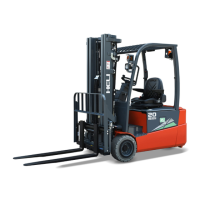34
3. Steering System
3.1 General Description
The function of steering system of forklift is to change the driving direction of the
forklift or keep the forklift in straight line driving. The performance of steering system
directly concerns with the driving safety, operation efficiency of forklifts and labor
intensity of drivers. The steering system is divided into two categories of mechanical
steering system (manual steering system) and power steering according to the power
source of steering. The mechanical steering system is operated to overcome steering
resistance moment fully by relying on the force and skill of driver, while in power
steering system, the energy consumed to overcome the steering resistance moment is
provided by prime mover and the driver can operate the system to control the turning
direction with very small force.
As requested by the working characteristic of the forklifts, the operation site and
driving pass are relatively narrow, changing-over is frequent and the minimum radius
turnings are often needed, therefore, the steering system is required to be reliable and
light in operation. Since the load of steering axle occupies about 60% of the vehicle
weight in case of idling, G-series forklifts of 1.0~3.5t produced by our Co. adopt fully
hydraulic power system to alleviate the labor intensity of the driver.
3.2 Working Principle
When the forklifts turn round, the steering moment applied by driver on the steering
wheel (steering control mechanism) makes steering wheel rotate and shift and is
transmitted to the steering gear through steering shaft. Steering gear sends the pressure oil
of appropriate volume to the steering oil cylinder through pipes and the oil cylinder
pushes steering wheel through trapezoidal steering mechanism, thus direction change is
realized.

